31
Progressive Thinkers as of 5/8/2020
|
| ||||||||||||||||||||||||||||||||||||||||||||||||||||||||||||||||||||||||||||||||||||||||||||||||||||||||||||||||||||||||||||||||||||||||||||||||||||||
Let me provide a previously offered image of the embellished Bigram idea expressed in the I-Ching triad reference:
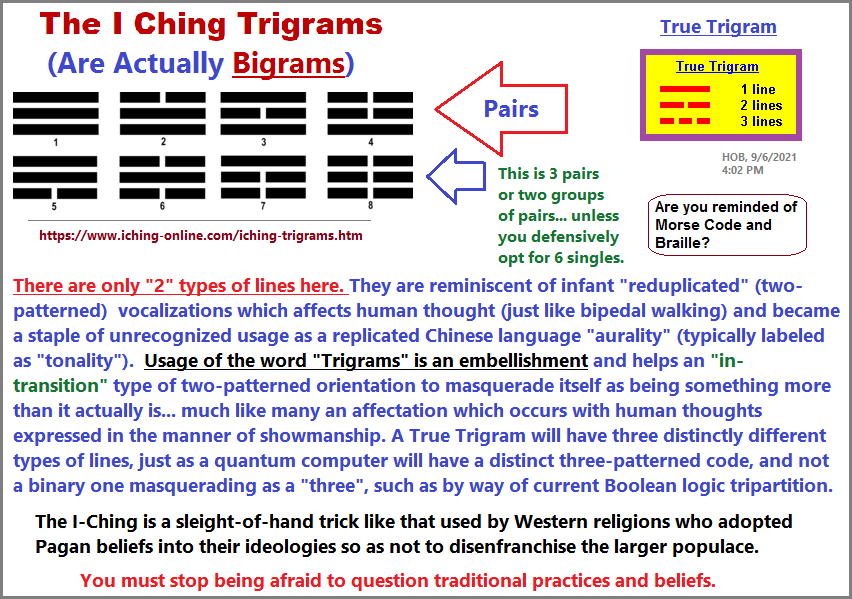
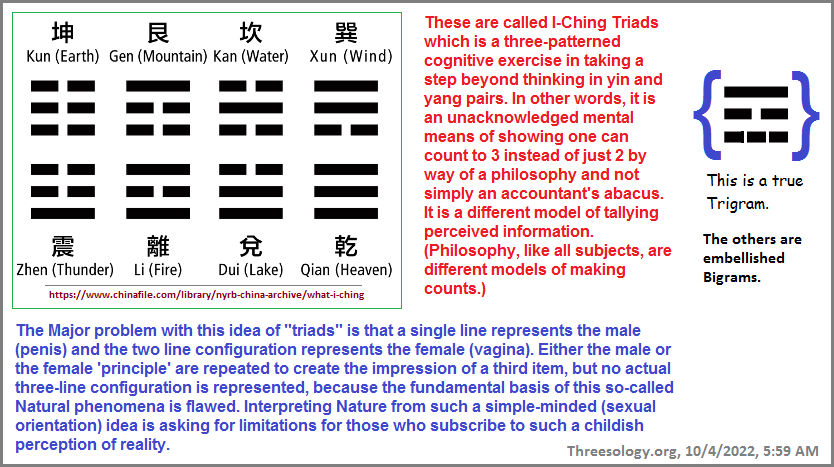
Just as the human species had a long and transitioning climb up the ladder of developing a sequential system of counting with stops and starts like that seen in the genetic code, the usage of conceptualizations using singular symbols is made more difficult in its efforts when the same cognitive activity formula attempts to use multiple symbols combined together, called letters which are formulated into groups called words which use three sentence ending punctuations called the period, question mark, exclamation point, and in using numbers the notation of created sets conforms to a sequence in which three numbers are separated by a comma, before the next grouping begins at the thousandth's place. In Morse Code we see a three-patterned assortment of a "dot space dash" configuration availability and in Braille we see a configuration of two rows of three dots. Let me also add an image of a Fresco Supposedly uncovered at the Pompeii site in which two Roman dicers are conflicted over the perception of whether the throw of dice equals two or three:
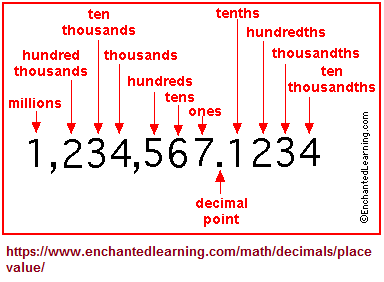 |
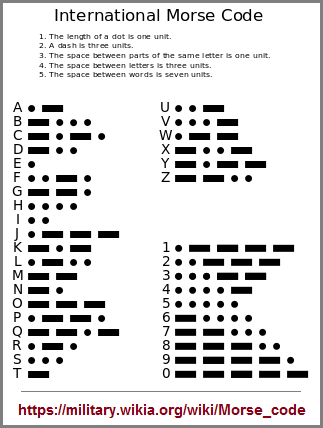 |
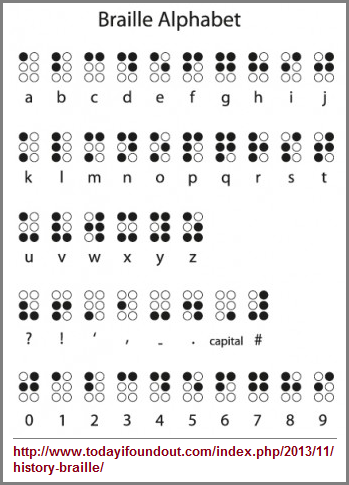 |
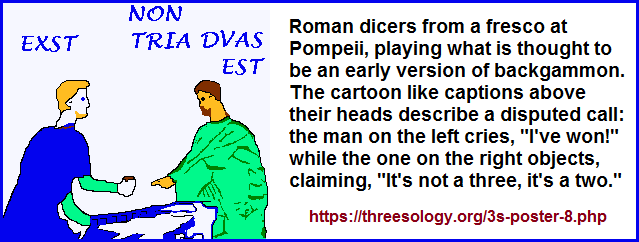 |
||
The last image can be further correlated to the old idea of (brain) Hemisphere attributes, whether or not you believe in it. While it is standard to see attributes being correlated with each of the brain's hemispheres, this idea has not been further developed to include a numerical association, just as different subjects are not looked upon as being different cultures whose ideas can be viewed in terms of a dominant thinking pattern profile which can be enumerated. By looking at the brain's attributes, one can clearly see a division between two and three-patterned references which invites the addition of a "1" notion when describing the reptilian complex of the brain, according to a triune brain idea developed by Paul MacLean.

In the 1960s, American neuroscientist Paul MacLean formulated the 'Triune Brain' model, which is based on the division of the human brain into three distinct regions. MacLean's model suggests the human brain is organized into a hierarchy, which itself is based on an evolutionary view of brain development. The three regions are as follows:
- Reptilian or Primal Brain (Basal Ganglia)
- Paleomammalian or Emotional Brain (Limbic System)
- Neomammalian or Rational Brain (Neocortex)
According to MacLean, the hierarchical organization of the human brain represents the gradual acquisition of the brain structures through evolution. The triune brain model suggests the basal ganglia was acquired first, which is thought to be in charge of our primal instincts, followed by the limbic system, which is in charge of our emotions or affective system, then the neocortex, which is thought to be responsible for rational or objective thought.
MacLean's model claims that activity in the three brain regions (basal ganglia, limbic system, and neocortex) is largely distinct when we are engaged in each of the mental activities outlined above. For example, when we are in danger and must respond quickly, as an act of self-preservation, the reptilian structure is aroused, preparing us for action by initiating the release of chemicals throughout the body. When we are watching a shocking news story or receive an upsetting message, the limbic system is stimulated and, again, chemicals are released, which create our experience of emotions. Finally, when we are making decisions, solving problems or reasoning, the neocortex is engaged, without the involvement of the other brain structures.
Modern advances in brain-imaging have shown various regions of the brain are active during primal, emotional and rational experiences. These findings have led to the rejection of MacLean's notion of a triune brain in neuroscience. However, while this model is undoubtedly an oversimplification, the concept of a triune brain provides us with a useful way of assessing human analysis of sensory information, in addition to the relationship between the structure and functions of the human brain (Gould, 2003). (The Concept of the Triune Brain by Andreas Komninos)
The reader may personally reject the idea of the Triune brain complex, but the fact that such a theory was even developed speaks towards a recurring human cognitive patterning preference.
Let me now supply a list of attributes assigned to the different hemisphere's of the brain, along with the additional reference of the Reptilian brain, in an effort to illustrate how a model of simple enumeration can be applied which describes the sequential development of the brain from the Reptilian ("1-patterned") past, to a right hemisphere (old mammal brain with a "2-patterned") orientation, to the later left hemisphere (new mammal brain with a "3-patterned") orientation, which can be further correlated with the patterns found in the heart and lungs, and that the opposite sides of the body are affected by cerebral strokes in either the left or right hemispheres. Here's an image of the brain's attributes:


(Note playground equipment suggest practiced dichotomies and possible positions of transitioning)
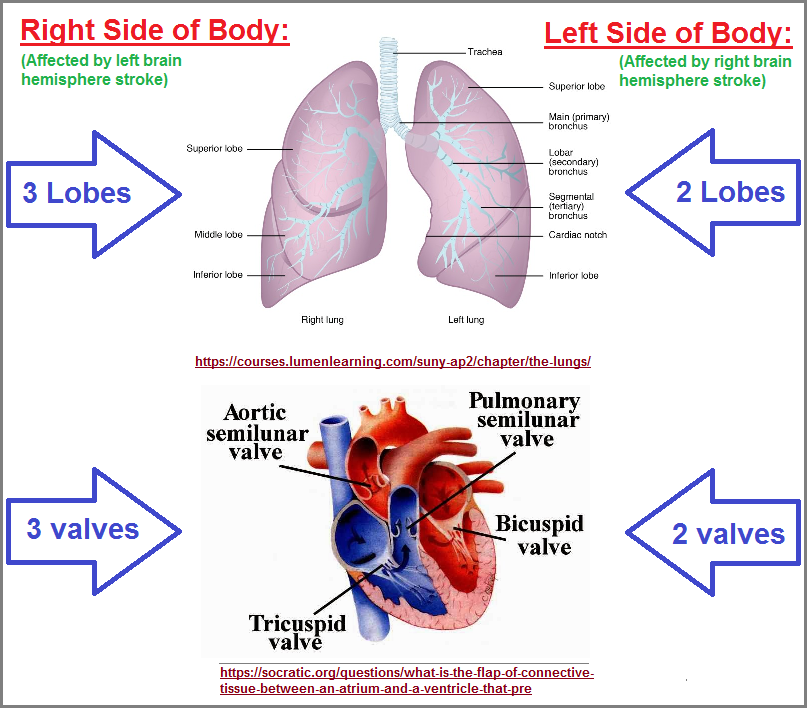
Some adventurous thinker might well want to develop an anthropology oriented correlation to the numbers associated with the brain hemispheres as well as heart and lungs to developmental cognition over time relevant to cultural standards. For example, different body parts are known to be of more importance to others in terms of feasting. Whether or not there is some underlying (though largely unrecognized) numerical signification that is assigned, might be determined. Perhaps similar to some animals sense of knowing a particular count is missing or present such as a brood of eggs. A primitive human mind might well have some unrecognized sense of enumeration though it is described by having a sense of something feeling right (a wrong count) or feeling right/ok (a right or approximately correct count). A primitive person might not be able to articulate that a count is off, it is just that something "seems" right or wrong with a given situation. An underlying count and an unspecified acknowledgment thereof may be at the core of different occasions involving superstitions, allusions, feelings, impressions, vague senses, etc... If a bird can count without knowing that they are engaging in such an activity when taking stock of a nest of eggs, then perhaps we might want to consider that humans exercise a similar behavioral activity in different circumstances to account for perceptions which are otherwise described as weird, strange, "something there", "something missing", "something not right", "there's a strangeness", etc... Could such references be primitive articulations of some unacknowledged accounting process taking place which can be differentiated by simple enumeration? Can human physiology detect enumeration but has not learned how to convey this detection to a brain too unevolved (or socially untaught) in its ability to process and illustrate environmental stimuli beyond some crude impressionism generally described in socially accepted forms of abstracted agreements accessed by the social standard of some convening authority figure whose labeling is permitted to set the trend for a current era's definition?
Each day brings a new challenge. I try to imagine some wayward soul searching the byways, hyways and let us say tryways of the internet in hopes of finding that one inclosure of thought by someone who may not necessarily be aware of their ability to share an insight into an otherwise neglected consideration of human perception that remains, for the most part, untranslated into readable text... if not some illustrated facsimile. However, in as much as I am constrained by the depth and reach of my walking stick with which I probe the reality within my purview... a stick which I can alternatively describe at times as my third leg or third outstretched arm; permit me to share at least a small tale of one such sojourn which is a compilation of multiple experiences which memory as served to catalog as a singular event:
I was awakened periodically by a succession of three knocks which alternatively sounded as if they occurred on the ceiling, the door, a window, an open shelf, and a wall. It was a very curious occurrence that I playfully mused on the happy-go-lucky realization of being visited by some spectral form that I entertained by using the label "Ghost", though much unlike the three ghosts of Mr. Scrooge or the three witches of Macbeth, though the singular ghost found in the trinity might be mused upon by some who are so inclined. I thought myself to be quite courageous when I openly called out with a calm voice "Hello There Ghost!" While at first there was silence and I turned from the consideration to begin getting dressed at the hour of 3:33 AM, I heard what sounded like a large ball bearing or marble being dropped on a wooden shelf nearby. As I turned, there again was silence. Thus I returned to my daily chore of getting dressed, when yet another 3 taps occurred. I had to smile and softly chuckle to myself thinking that my spectral familiar was playing a game, to which I had not but to engage in and speak out loud with the commentary refrain that they should do it again. Oh but surely my imagination must be somehow mixed with some left-over sleepiness which creates such a drowsiness. And yet, there again a third succession of three taps of the ball bearing/marble. As I hurriedly opened each drawer and cabinet in search of spectre's instrument of clandestine mimicry, all I found was an emptiness. Nonetheless I was immediately poised quite intently on my surroundings to peer through the dimly lit silence in search of yet another three-patterned episode. Yet, none would avail my concentrated effort to discern the exact whereabouts of the former event.
As I sat thinking about the events, I came to the conclusion that the spectre meant no harm and was employed by someone or something to force me not only into consciousness from my slumber, but to think about episodic trail of threes. While I was already engage in a quest for multiple expressions of the threes idea occurring in different sectors of thought which are otherwise labeled as subjects, I came to the conclusion that the patterns-of-three were being emphasized with an intent to brand them onto an active portion of my thinking. A thought that was quickly followed in passing by the three-bark baying of a neighborhood dog! A three-patterned hook as they say, used in many popular songs since the dog did the three-bark sequence three times! What else could I do but openly laugh at such a repetition that was then followed by a distant honk of a vehicle's horn emitting three shrill beeps! All of this was really too much until I heard the early morn chatter of three people engaged in a morning walk conversation which involved the number 3, though I am sure they were not aware of its application to my own events.
But the idea of taking a walk was thought to be a good idea so I gathered pen and pad to jot down any threes occurrence which I might encounter which would first be added to memorization but would quickly overwhelm the limitations which the human capacity has been found to exhibit, yet Mr. Miller's account of 7 plus or minus 2 is a generalization too often overlooked as itself being a three-patterned expression involving the three numbers of 5, 7 and 9. And though his paper is sometimes referred to as a classic, the "classic" label is best preserved as an illustration of how very classic is the number of people who overlook the presence of three-patterned expression used to convey a researcher's obsessive compulsion with a number pattern without a regard for the occurrence of other number patterns.
Nonetheless, despite this digression of thought as I began my walk, there occurred three cats chasing one another across the street onto multiple yards. And though I didn't bother to include the occasion onto my notepad, I thought that I should because it was not an unusual event taking place during different sessions of walking. Nor was it unusual to encounter three early morning birds chirping together or hear a succession of three caws from what one might describe as a crow or blackbird. Yet, none of these were recorded since I took them for granted as events which were very commonplace. However, to chance upon three pennies than a quarter and a nickel, would be recorded and eventually recognized as equal to 33 cents! If not this combination of coins, then three dimes and three pennies, though I would sometimes pickup different combinations valued at a lesser or greater sum. Yet, this does not betray the frequency to which I have encountered find three separate coins or three balls, or three toys or three pieces of debris such as thrown away beverage cans. All of which I too did not record in my walk-a-bout journal.
To myself I would name different examples of threes others have found in Fairy tales, Physics, Sports and day-to-day expressions such as Home-Sweet-Home, How's it going?, What you doing?, What;s happening man!, and multiple others. I would also survey my memory for patterns-of-three in grammar, linguistics, biology and music. Dr. McNulty's repository of Threes in human Anatomy is a frequent favorite of mine to reflect on, as is Mark Mahon's Nature Loves the Number Three listing and the numerous examples of threes from Michael Eck's Book Of Threes. But my curiosity about the threes phenomena is not limited to creating a list of different threes examples, because this alone does not beg the questions of why, where did it come from, where is it taking us, and how is it that there some people more prone to its calling than others?
As I walk and encounter a neighbor's flag with three colors or a traffic light with three colors, or the frequent groupings of people into single, double or triples, or espy a gas station offering three different grades of gasoline... noting that diesel is a fuel oil and is thus to be considered separately; there is some troubling thought which could well lead one into a misadventure of consideration, if they took notice that most people do not engage in some sort of memorization which actively sorts observations into enumerated categories. While there are those actively involved with some creative application of their many perceptions being applied to a given artistic task, which includes mathematics as an artistic endeavour, the means by which most people engage in memorization as illustrated by their collections of different household wares, is particularly simplistic and rather humorous if one takes the time to make such a deduction of such practices. For example, clothes are typically kept in closets and drawers, except for those whose organizational efforts are aligned with some undiagnosed severe memory limitation which forces them to place items close at hand to which they guard over like a dog with a bone.
It is not too infrequent that I get so caught up in my threes excursions that I find myself having walked a distance past a street that would have taken me quickly back to the point of departure, yet I have walked three blocks beyond the turnoff. It matters not, since the objective was to get some exercise along with perusing my interest in the threes phenomena as it might be encountered from a different vantage point. And upon my return I remember that I have set before me three tasks needing to be taken care of usually involving some mechanical, plumbing, carpentry, landscaping, electrical, appliance repair, or other construction problem which might include a do-it-yourself furniture assembly accompanied by a pamphlet containing three languages, such as English, French and Spanish.
As a researcher into the "threes" phenomena, I have come to not expect any intelligent response from those who are considered experts in their respective fields of interest, even though they may have come to mention (in passing) a reference to having noticed a repetition of threes or acknowledge someone having made mention of it. For example, decades ago I contacted (via a letter) Bruno Bettelheim (the fame child psychologist) and asked him where "threes" occurred so prominentally as to having an effect oh human thinking to produce such a repetition. He replied the two testicles and penis. In another letter I wrote to Murray Gell-Man (of Physics fame) and he replied with a postcard emblazoned with some cryptic message I can not remember verbatim, but suggested I was indulging in some sort of esoteric endeavour. In a third letter to Arthur C. Clarke (of Science Fiction fame), he replied that he preferred the number 7. In other contexts I have spoken directly to theologians, business people, mechanics, philosophers, farmers, housewives, strangers at stores and on the street, and multiple others whose professions I am not aware of. And I have even tried my hand at communicating with those who were quite familiar with the "threes" repetition in Fairy Tales or some other literary expression. I came to find that all of them have some very primitive knowledge of the "threes phenomena"... mainly I suppose, because that is all that has existed.
While I have come across a few that emphasize using a "rule-of-three" for a given purpose, none of them have been able to provide an extensive list nor study effort directed towards the "repetition of threes" idea, particularly in concert with an acknowledgment of its absence, along with the presence of an overall limited array of patterns being used. I have had to create such a study with the assistance of the materials provided by numerous researchers who have expressed an extended interest in the phenomena. While some list the "threes" in mythology, others in legends, and other in Fairy Tales, there are others who have taken the time to compile examples from different subjects. But I have also encountered those who have compiled lists of different number values such as (for example) twos and sevens. On the other hand, those interested in Numerology have taken the time to list numbers assigned with different qualities in an effort to provide different people with a proposed insight as to why a given number apparently re-occurs to them. But such Numerological accounts do not routinely take into account that the lists of all Numerologists is quite small, when compared to the infinity of numbers at our disposal. Such a limitation is a cognitive repetition that cognitive scientists do not taken into account when they are devising their theory of some cognitive standard.
All human ideas, no matter how stupid, silly, serious, etc., one might otherwise consider one or another idea to be... needs to be considered if we are to establish some comprehensive perspective of human cognitive activity which has been reduced to some valuation which enables all ideas to be catalogued, compared and measured. Is it appropriate to use enumeration or should some other system of intended measurement be used? Until someone comes up with a better means of measuring, numbers can be used. Unless one thinks that a given type of thought processing can not be quantified because it is associated with a topic (such as god) and such a topic is outside the realm of human understanding, we can nonetheless assign such contemplations with a numerical index. The pattern being used as a measuring stick can also be quantified to indicate either its similarity or difference(s) to other ideas with the same intention. If the same underlying pattern is being used but different labels are being applied, do the different labels actually alter the underlying pattern, or simply act as a type of cultural camouflaging technique to conceal the same pattern being used but want to imply a different schematic where none actually exists? For example, just because one culture calls their one god Fred Flintstone and another culture calls their one god Tweety bird and still another culture calls their one god Scoobiedoobie, does not change the fact that all of them repeat the idea of a single god, even if the research overlooks the fact that they are making reference to three cultures and that there may be three researchers involved in a three-week survey during the third hour of the third day of the third week of the third month in a year ending with the number 3. Or that each of the researchers have three kids, three pets and are a three-vehicle family.
I can't tell you how many times I have come across a research team with three investigators using three subjects over a length of time involving some value of three such as three weeks, or three months, or three years... that may involve three independent research groups... as if such a compilation adds more weight to the findings. Just because you have a thousand researchers and three subjects or three researchers and a thousand subjects studied over a 3-week, 3-month, or 3-year period does not mean the overall evaluation is to be persuaded better or worse... but such patterns may well influence readers who are predisposed to interpreting something more positively or negatively based on some perceived pattern they may or may not consciously acknowledge. Numerical biasing is rampant, because we do not understand human cognitive patterning well enough... in ourselves or others, particularly out of a practiced context. Whereas you might understand political behavior quite well, this often is in concert with a given context... much like a police officer being skilled at apprehending criminals who act out similar cognitive patterns in similar contexts, without being aware they are doing so, and a police officer's knowledge based on repetitions in a given context enables them to give the impression of being knowledgeable, even though police officers are not known for having some degree of superior intelligence applicable to multiple different contexts.
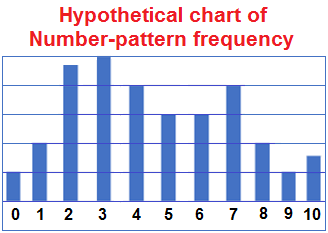
By studying the repetition of "threes" patterns in different contexts, I have also become aware of its absence and the presence of some other pattern. If we then take the accounts of the different patterns which come to mind in our observations, a tally sheet of the different patterns can be illustrated. Take for example the accompanying hypothetical chart of numbers. The intent is to display that I have encountered different frequencies of occurrences for different numbers being viewed as patterns or "pattern-numbers/number-patterns". Some occur more frequently than others, but that when we take into account the actual infinity of numbers at our disposal, humans are only using a very small measure of those that are available... much like those who claim humans only use 10 percent of their total brain's capacity/capability. This is why I say that there is a conservation of number having a major residence in human cognition which must be taken into account when looking for some presumed standard cognitive pattern to be exploited for some other application. We have got to get a firm grasp on human cognitive limits... particularly whether or not the limits are increasing/decreasing and what is creating such a condition such as the idea of incremental deteriorations of the environment which predispose us towards al alteration for survival purposes... suggesting we are likewise disposed towards the usage of rationalization as a coping mechanism for consciously acknowledging adaptations that in former years would have been considered illogical, discriminatory, prejudiced, etc..., used under the guise of defined necessity, protectionism, nationalism, tradition, sacredness, worthiness, rightfulness, etc...
For example, in the extreme, is it important which race is dominant if all races face the same eventuality of extinction? How are we to define importance of the entire human race is facing an eventual extinction because we fail to identify and measure changes in cognitive activity which act as a barometer of environment unrecoverable degradation instead of as a presumed indication of evolutionary development towards an improved species?
Several subjects (for instance... Psychology, Philosophy, Anthropology, Architecture, Biology, Sociology, etc.,) provide examples of human behavior and/or human ideas, while anatomy and medicine (as well as biology/genetics and chemistry), provide opinions as to the form and functionality of human physiology and /or physical properties. While researchers and general readers of one or another subject come to identify patterns, it is not very often we find textbooks or even popular writings which attempt some amalgamation of all the different patterns to the extent of identifying that there are only a handful of patterns being used over and over and over again. Whether you use some model of enumeration or geometry, or other symbol(s), we can come to appreciate the presence of a repetition. And the recognition that such a repetition of only a few patterns is and expressed conservation. Let us further describe this as a conservation of number, and/or conservation of geometric design, or conservation of whatever particular pattern captures your fancy. There is not an infinity of patterns being used.
And no matter what rationale you might use to provide a reason for this conservation, the fact that it persists suggests that it is a requirement of survival. And though humans have made mention of recurring ideas that may or may not have been further subjected to some scheme of itemization that is enumerated or otherwise subjected to some compartmentalized label for further scrutiny and comparison with other ideas; there has been no active interest or effort to catalog the patterns for the purpose of identifying whether they are increasing, remaining the same, or decreasing in use. I am not talking about the same patterns being used by larger quantities of people as a population increases, but whether or not a given pattern is on a course of increased or decreased usage... if not obsolescence. In other words, is a given pattern becoming more of a survival necessity or less of one, because such changes in pattern usage indicates environmental pressures for a given survival requirement have been altered.
For example, according to historians, ancient humans generally favored an interest in having multiple gods which has degenerated over time to produce a condition where most people generally accept the notion of a single god. In other words, we might generally state this as a "Many to One" change, which some might interpret to be close enough in wording and functionality to be represented by the "out of many, one" slogan found in the E Pluribus Unum phrase seen on the US presidential seal. Indeed, one might also make reference to the early counting efforts of humans which can be generalized by the three-word description of "One, Two, Many". It is a three-patterned phrase which expresses the rudimentary attempts made by humans and indicates the presumed slow pace in which higher and higher forms of enumeration were first met with cognitive stops and starts. For example, an early human at some time, in their own language equivalent way developed a concept which we of today might recognize as "1", though the early human may have made some sort of snorting sound or some sort of "ugh" designation. But whatever the actual case, the concept of the quantity "1" was established, whereby all other quantities at first may not have had a specific value and was referred to with some notion equivalent to "much, many, all, heap, bunch, etc...", which is similar to our present day notion of infinity. Though the primitive's idea of infinity was for any quantity beyond one, or beyond two... etc., the general idea is to provide a condensed expression with supplies the summation we of today consider to have been the possible course of development with regards to a sequence of numbers being developed by early human thinkers. While someone might prefer a phrase such as "One-Many, Two-Many, Three-Many", I will use the "One-Two-Many" expression.
For whatever reason, humans did not automatically think in terms of a large sequence of numbers, much less engage in the elaborations of those numbers embellished with other symbols placed into different configurations which we call equations. Nor did early humans automatically think in terms of developing a dictionary or encyclopedia or the light bulb for that matter. It is thought by some that the early human brain was not equipped to conceive of numbers or even language as we know them today. And because both language and the use of numbers are poorly established throughout the word in so many people, it is safe to say there remains a rather crude level of development in these regards for the human species as a whole. Nonetheless, there are identifiable patterns when human behavior and thinking are subjected to some measurable form of itemization. However, it is thought by others that there has been little change in the development of the human brain and that if we put early humans in the context of a modern social upbringing, they might well be able to learn the grasp of numbers and language as any child of today does. Yet, it is rather a moot point since the experiment can not be put into effect without the presence of some early human. Then again, one must wonder how easy or difficult would it be for a present day child with its mental capacity to fit in with the primitive cultures of long ago... would they be trend setters or revolutionists? Scribes, priests, criminals, physicians, sooth-sayers or vagabonds? Perhaps the modern brain subjected to the superstitions of the past would produce the demons of conflict and have to have them removed by a process of trephination?
In searching for recurring patterns (even the absence of one or another pattern is a repetition); some of us have turned to an examination of human physiology/anatomy since it can be said that the human brain is akin to a computer's processor and the different senses are arranged like a prism which creates a spectrum through which reality is absorbed, reflected, refracted and transmitted. While earlier researchers came to the realization of counting the quantity of senses after listing them: (hearing, seeing, touching, smell, taste) which equals five, others have attempted to add to this list by suggesting (claiming) some people are equipped with an extra-sensory perceptibility which permits them to perceive subtleties such as spectrums of color, energy, sound and that which is typically imperceptible by the common senses. For example, instead of the typical two eyes, some have claimed there exists a third eye, sometimes described as the light sensitive pineal gland. Hence, we have gone from a "2" count to a "3". Interestingly, if we look at basic genetics, we see that Nature itself has engaged in a simply counting sequence in that RNA is single-stranded and DNA is double-stranded; where some believe there existed an "RNA world" which preceded the present "DNA world". Hence, we see the count of "1" proceeding to "2". Likewise, we see a simple counting sequence in germ layer development from less complex life forms having a Diploblastic (2-ploblastic) configuration and the presently most complex life forms with a Triploblastic (3-ploblastic) modeling. As for what I describe as a "Monoploblastic" (1-ploblastic) life form, we have the sponge... though some researchers disagree with this assessment, but I use it because I have found other researchers who provide the sponges as a candidate.
When looking at the human body, aside from the two-examples in the foregoing paragraph, it is of interest to note that there is an identifiable pattern-of-three being repeated as indicated by Dr. McNulty's (and Associates) List of threes in human anatomy. However, one of the major processes of anatomy involving language (and language's influence on thought in general and more specifically... mathematics); is the form and functionality of hearing. I have tried to emphasize this numerous times and you will encounter me repeating this on different pages in different discussions. Whereas you might want to say it's a coincidence that there is a repetition of patterns-of-three, the fact remains is that we must consider that our thinking might be different if the ear was structure with some other value. And this is another point to emphasize. That we can actually create the mechanism of hearing with different patterns because the process of hearing can be reduced to our present day understanding in the scope of utilizing the dichotomy of input and output, just like the development of life forms using a mouth/anus dichotomy in their early development. Take a look at this illustration of the ear:

While one might argue that the recurring presence of "threes" might have some ear-related influence, then why don't all perceptions involve a pattern-of-three, unless it is dependent on a buffering system involving a 1-2-3 maturation system, and that the totality of the human anatomy and not just the ear has an influence on perception and the processing there-of? For example, could not the bi-pedal gait over millions of years played a role in thought formation, which took over from a hand to hand swinging motion due to brachiation of more ancestral humans remaining close to trees for living? And what of the other patterns such as one might describe as having four limbs, unless this is a false collectivity of mind and it should actually be only two upper and two lower. In any respect, how does the prism of the body come to determine which pattern to use over others? Is there a hierarchy based on genetics? Diet? or some cultural influence which suggests that the prism of the human body is malleable... that the presumed hierarchy of cognitive assignment is malleable while one is young but more solidified as one gets older... much like language acquisition? And though one might claim a numbers such as "7" is their favorite, they actually have a daily preferential use of patterns-of-three or some other pattern?
(Second half of this moved to page 29)
Date of (series) Origination: Saturday, 14th March 2020... 6:11 AM
Date of Initial Posting (this ): 1st March 2022... 6:04 AM
Updated Posting:Sunday, 6th November 2022... 8:51 AM, AST (Arizona Standard Time); Picture Rocks, AZ.